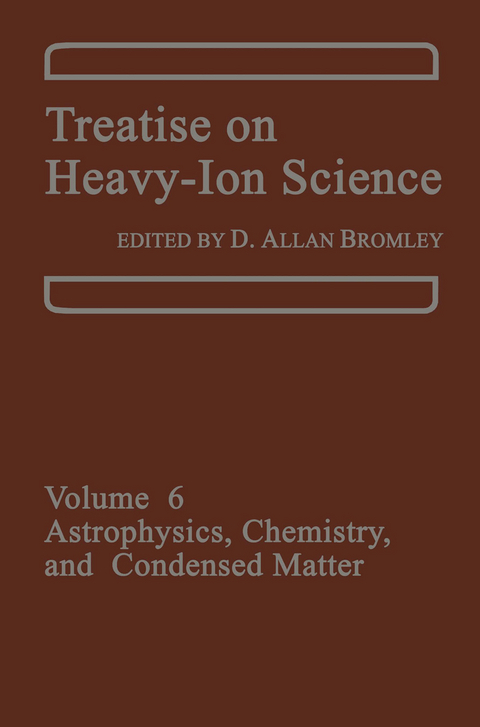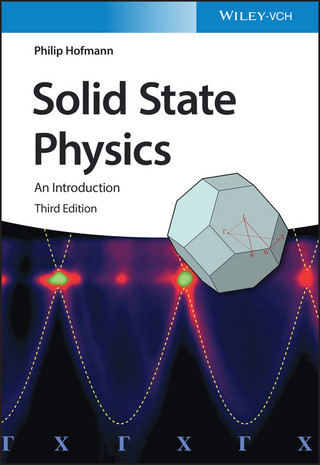
Treatise on Heavy-Ion Science
Springer-Verlag New York Inc.
978-1-4615-8105-5 (ISBN)
23 an analysis of the stopping of charged particles by matter, and each contained many of their divergent ideas on the model of an atom. Thomson ignored in his paper the Rutherford alpha-particle scattering 24 experiment of a year before. But the nuclear atom with a heavy positively 25 charged core was the basis of Bohr's ideas.
1. Heavy-Ion Reactions in Nuclear Astrophysics.- 1. Introduction.- 2. Nuclear Astrophysics.- 3. Measurement Techniques for Sub-Coulomb-Barrier Heavy-Ion Reactions.- 4. Experimental Data.- 5. Reaction Model Calculations.- 6. Concluding Remarks.- Note Added in Proof.- References.- 2. Heavy Ions in Hot Atom Chemistry.- 1. Introduction.- 2. Chemical Reactions Promoted by Accelerated Ions.- 3. Heavy Ions from the Spontaneous Decay of Radioactive Precursors.- 4. Collision-Induced Coulomb Explosion of Fast Molecular Ions as a Structural Probe.- References.- 3. The Stopping and Range of Ions in Matter.- Abstract.- 1. Introduction.- 2. Stopping Power Tables.- 3. Range Tables.- 4. Electronic Stopping of Ions.- 5. Interaction of a Particle with a Free Electron Gas.- 6. Nuclear Stopping of Ions.- 7. Range Theory.- References.- 4. Ion Implantation.- 1. Introduction.- 2. Dynamics.- 3. Metals.- 4. Semiconductors (Si).- 5. Ion Beam Mixing.- References.- 5. Heavy-Ion Channeling.- 1. Introduction.- 2. Trajectories and Interaction Potentials.- 3. Energy Loss in Channels.- 4. Charge Changing Collisions.- 5. Resonant Coherent Excitation.- References.- 6. The Electronic Polarization Induced in Solids Traversed by Fast Ions.- 1. Introduction.- 2. The Wake.- 3. Experiments with Fast Molecular-Ion Beams.- Acknowledgments.- References.- 7. Erosion of Surfaces by Fast Heavy Ions.- 1. Introduction.- 2. Sputtering at Low Energies.- 3. Sputtering at High Energies.- 4. Applications.- 5. Summary and Conclusions.- Acknowledgments.- References.- 8. Heavy-Ion Damage in Solids.- 1. Introduction.- 2. Low-Energy Irradiations (E < 5 keV).- 3. Medium-Energy Irradiations (5–200 keV).- 4. High-Energy Irradiation (E > 200 keV).- References.- 9. Analysis with Heavy Ions.- 1. Introduction.- 2. Nuclear ReactionAnalysis of Hydrogen in Solids.- 3. Rutherford Backscattering Spectrometry.- 4. Nuclear Recoil Analysis.- Acknowledgments.- References.- 10. Heavy-Ion-Induced Fusion Power.- 1. Introduction.- 2. Heavy-Ion Drivers.- 3. Targets.- 4. Reactors.- 5. Prospects.- Appendix A: Statement of USDOE on Declassification Actions Issued on September 4, 1980.- Appendix B: Excerpts from the Public Transcript of the May 3, 1979 Meeting of the USDOE Energy Research Advisory Board; Testimony of Dr. John Foster, Reporting on the Conclusions of the ICF Review he Chaired in 1979.- References.
| Zusatzinfo | 214 Illustrations, black and white; XXII, 429 p. 214 illus. |
|---|---|
| Verlagsort | New York, NY |
| Sprache | englisch |
| Maße | 152 x 229 mm |
| Themenwelt | Naturwissenschaften ► Physik / Astronomie ► Atom- / Kern- / Molekularphysik |
| ISBN-10 | 1-4615-8105-2 / 1461581052 |
| ISBN-13 | 978-1-4615-8105-5 / 9781461581055 |
| Zustand | Neuware |
| Haben Sie eine Frage zum Produkt? |
aus dem Bereich


